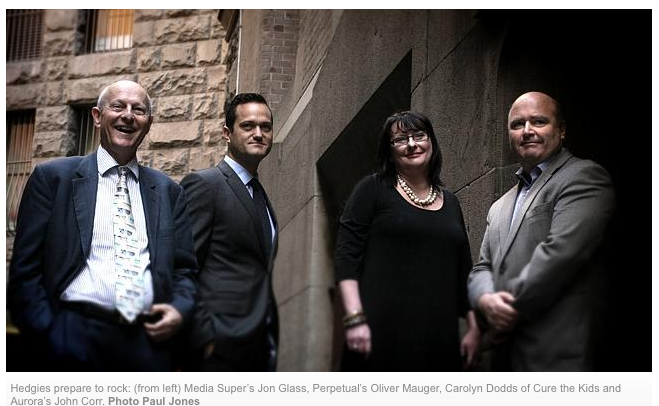Australia’s hedge fund community will gather at the Ivy Ballroom in Sydney this evening for Hedge Funds Rock, their annual charity and awards gig. More than $2.5 million has been raised for Cure Our Kids since hedgies first shaved their heads to raise money for children with cancer in 2001.
In 2012, Australian hedge funds are fighting their own battle for the attention of cashed-up institutions, which are scaling back their exposure to hedge funds or opting to side with large global players. Assets under management for Australian hedge funds are about $43 billion, just a drop in the bucket of a global $US1.74 trillion industry that is concentrated in America.
While total superannuation funds under management are believed to be nearly $2 trillion, institutions allocate the bulk of their estimated 3 per cent invested in hedge funds to offshore managers.
The nation’s largest pension fund, the $76 billion Future Fund, has a stronger preference for hedge funds, allocating $11.9 billion – but again, mainly to international managers.
“Large allocations to hedge funds are still made from US pension funds but we’re seeing very little of that flow in Australia,” Aurora Funds Management chief investment officer John Corr says.
K2 Asset Management managing director Campbell Neal adds: “It’s incredibly tough and near impossible to find institutional support for hedge funds.”
Even investors agree. “They [local institutions] pretty much ignore the industry,” Media Super chief investment officer Jon Glass says.
Corr says local institutions allocate to the larger international brand names, even if their risk profiles are similar to Aurora’s or not as good. “It seems to be a belief that these things can’t be done in Australia,” he says.
Sunsuper is one of the higher allocators as 7 per cent of its balanced option is in hedge funds, but Bennelong Asset Management is its only Australian manager in a portfolio of 20 funds. Sunsuper was previously invested in Everest Financial Group – a local fund that is winding up after being hit by a leveraged client base during the credit crunch and legal action.
“Some Australian managers are very good, but the universe is more limited,” Sunsuper chief investment officer David Hartley says.
“There isn’t as much scope for managers to hedge positions but in the US there is more choice and flexibility. A number of institutions were exposed to fund of funds [an investment strategy] and it did not always meet their expectations,” Hartley says and adds Sunsuper used Everest mainly to facilitate introductions to offshore hedge funds.
Frontier Advisors deputy director of consulting Kristian Fok points to greater opportunity for offshore players, given that hedge funds seek to profit from market dislocation. Consequently, Australia’s greater fiscal responsibility means fewer opportunities for local managers in the aftermath of the credit crisis. “Local institutions tend to be allocating to offshore hedge funds because opportunities are greater where the market dislocation is much greater,” Fok says.
He gives the example of non-conforming loan portfolios – which represent rich opportunity for the hedge funds – that hold detailed information on borrowers. Depressed property prices and risk are priced into these packages.
“If something is complex, you need to be sure the fundamental investment case makes sense before you rely on the skill set [of a manager],” Fok says.
The local recalcitrance towards hedge funds is ironic since Australia gave birth to the asset class (trivia that won’t appear on a citizenship test). In 1949, Melbourne-based financial journalist Albert Winslow Jones began using the wonders of leverage and short selling to make returns independent of the broader direction of the stockmarket. His experiment earned him the title of the father of the modern hedge fund.
Jones’s legacy lives on with Australians such as Greg Coffey, Michael Hintze and Hilton Nathanson, who are among Britain’s wealthiest hedge funds managers, according to the Sunday Times Rich List.
Despite the achievements of these Australians, Aurora’s Corr says very little of the allocation to hedge funds by local investors and US pension funds flows in Australia.
“In a low interest rate environment, investors are searching the world for returns but distance and the tax regime are still concerns [when considering Australia].”
Oliver Mauger of Perpetual Investments spent several years working in Switzerland – the first jurisdiction to embrace hedge fund investing. He agrees that Australia’s industry is still in a burgeoning phase, trailing behind the centres of New York and London. But he sees hedge funds as growing in importance as Australian funds come to terms with the global financial crisis.
“We are talking about it as an asset class but it’s a huge, heterogeneous universe of many different strategies. Hedge funds are a structure that allows you to take different types of risk out of the market,” he says.
Media Super’s Glass says the emergence of hedge funds comes amid serious soul searching among superannuation funds about their approach to investing.
The loose strategy of broadly allocating money to equities whilst “playing around on the edges” had served funds well for close on 15 years, he says. But it stopped working in 2008 and there’s division as to whether retirement money management needs an overhaul.
“There are those that think it will start to work again any day soon and there are those that think, ‘Hang on a second, there’s a bigger world of securities out there, and there is more to access in the capital structure than just equities’,” he says.
PUBLISHED: 19 Sep 2012 20:16:57
Written by Jonathan Shapiro and Jane Searle

